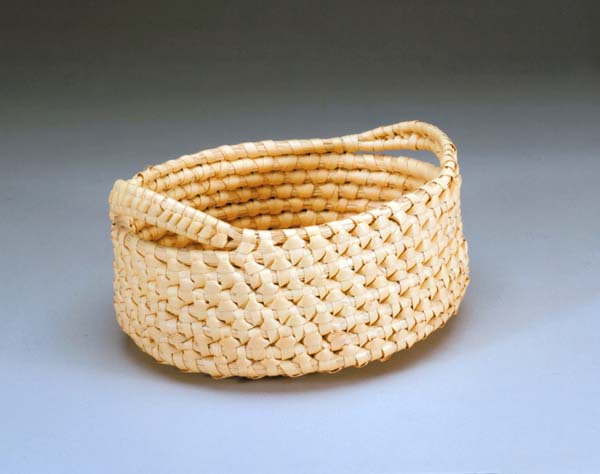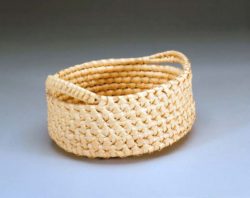Janie Verret Luster
Janie Verret Luster is a master palmetto basket weaver and cultural preservationist of the United Houma Nation, a state-recognized tribe from southeast Louisiana.

Courtesy of New Orleans Museum of Art.
"Basket with Handles," ca. 1998-99, by Janie Verret Luster.
Janie Verret Luster is a master palmetto basket weaver and cultural preservationist of the United Houma Nation, a state-recognized tribe from southeast Louisiana. A dedicated practitioner of diverse tribal customs, she is widely recognized for her coiled half-hitch baskets, made using an intricate weaving technique lost to the Houma for nearly a generation. Reintroduced by Luster in the 1990s, the hitch-coil method with a half-hitch knot—common in areas of South and Central America—is considered limited in North America to Louisiana’s largest tribe of indigenous peoples.
Luster was born in 1952 to Mary and John Gustave Verret Sr., and raised in the community of Bayou DuLarge in Terrebone Parish, where she resides today. As a child she became immersed in tribal culture, learning, for example, the Houma-French language spoken by the tribe for nearly three centuries. She studied herbal folk healing using indigenous flora, a practice handed down from an ancestral traiteuse, or medicine woman. Like generations of Houma women before her, she also mastered the craft of palmetto-frond plaiting to make fans, hats, mats, and baskets using a flat hexagonal weave.
In the early 1990s, Luster became interested in the coiled half-hitch, an ancient, and laborious, weaving technique that had disappeared from the tribe sometime in the 1940s. Luster recalls seeing pictures of half-hitch baskets in a slim volume about tribal life at the time of European contact titled I Heard the Song of the Houmas: J’entends la Chanson des Houmas (1992). She soon had an opportunity to see a half-hitch palmetto basket firsthand when Richard Conn, then curator of Native American art at the Denver Art Museum in Colorado, traveled to southeast Louisiana with one in hand from the institution’s collection. Leading a workshop at the Houma community center, Conn used ribbon and rope to show participants the basic weave. Luster began practicing at home and, in 1998, presented the Denver Art Museum with her own meticulously rendered half-hitch palmetto basket, thus bringing the lesson full circle.
Baskets are made using dwarf palmetto (Sabal minor) collected from the swamps and bayous common to southeast Louisiana. Traditionally harvests followed the lunar cycle, with fronds being gathered during a full or new moon; however, today they may be collected whenever need dictates. Fronds cut from the preferred heart of the plant are allowed to dry, a critical process that may take several weeks depending upon the weather, and then cut into strips. Before a weaver begins assembling the basket, however, the narrow bands must be soaked in water to increase their pliability. The coarser strips derived from the blades’ outer edges are, in turn, gathered into bundles and wrapped with the flexible strips cut from the leaves’ soft middle. The weaver must then coil the secured bundle around itself to begin forming a base and building the basket’s sides. Modestly scaled baskets may take twenty-four hours to complete, while larger works often require several days or weeks.
In addition to baskets, Luster makes dolls from cured Spanish moss and jewelry and home decor using the dried diamond-shaped scales of the alligator gar (Atractosteus spatula), a ray-finned fish native to the southeastern United States. Luster demonstrates her traditional crafts at various cultural events across the state, including the New Orleans Jazz and Heritage Festival, and has passed on her skills to her children and grandchildren, who frequently join her at such gatherings. A tribal council member, she has been the recipient of the United Houma Nation Cultural Preservation award as well as the Louisiana Division of the Arts Folklife Fellowship award. In 2011, Luster was inducted into the Louisiana Hall of Master Folk Artists.
